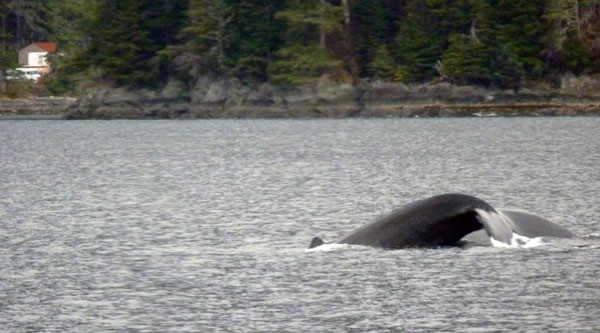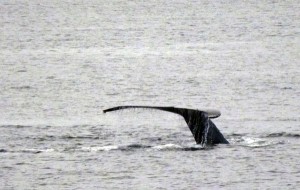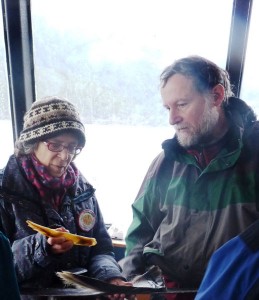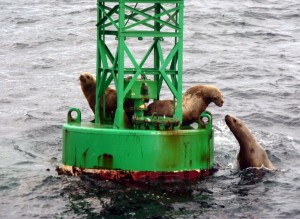
There’s a baby boom going on with Alaska’s humpback whales.
Slow-but-steady population growth is good news for the species, as well as whale-watchers. But it could be bad news for boaters, hatcheries and the herring fleet.
The healthy population was visible during a boat tour held as part of the Sitka WhaleFest Science Symposium, held Nov. 1-4.

“There’s a few more whales further out. I’m not sure if they’re whales we’ve had close views of this morning, but we’ll find that out,” says Capt. John Dunlap as he pilots a catamaran through a protected area of Sitka Sound.
The Allen Marine vessel is carrying several dozen passengers, plus expert marine biologists.
One is Jan Straley, festival science director and a University of Alaska professor who’s studied the marine mammals for more than 30 years.
“The population increase in humpbacks is going gangbusters,” Straley says.
“They are reproducing at about 6 to 7 percent a year in Southeast Alaska. So that means for every hundred whales we get six or seven more whales the next year. And their mortality rate isn’t that high, so we’re just getting more and more whales, which is a good thing, but it also comes with some problems,” she says.
Those problems aren’t evident on this day. Passengers gather on deck to watch, photograph – and hear – some of the sound’s spouting humpbacks.
The numbers are up as the species continues recovering from global commercial whaling. But researchers say trouble’s ahead, as the population grows.

John Moran is a research biologist with the National Marine Fisheries Service in Juneau.
“The amazing thing is that there’s not more issues. There’s a lot of cruise ships, a lot of whales, and there’s a lot of gear in the water,” Moran says.
Whales do get hit and killed by the big ships. And they do become tangled in commercial fishing lines. But Moran is more worried about interactions between whales and skiffs, cabin cruisers and other small vessels.
“People don’t really pay attention when they’re driving boats like they do when they’re of driving a car. And small boats are fast and whales are big. And it’s like hitting a brick wall and I don’t think people fully realize that,” he says.
Passengers watch several whales arch their backs, show their tails and dive. Captain Dunlap asks everyone to keep their eyes open.
“We’re in relatively deep water. It’s over 350 feet deep here. And depending on where these whales are feeding, they could be down for quite a while,” he says.
Some people think humpbacks eat only krill, a small, shrimp-like crustacean filtered out by their baleen. But Straley tells the whale-watchers they also feed on fish.
“There’s a nice layer of herring right on the bottom that’s about 80 fathoms deep. So these whales come right now, and they’re feeding prior to their migration, just bulking up because they don’t feed a lot in Hawaii,” she says.
That’s where most Sitka whales go during winter months. Some also swim from Prince William Sound and other locations to Mexican waters.
Research shows the growing humpback population eats enough herring to reduce local stocks.
Moran says they take about 20 percent of the biomass in Prince William Sound — about the same as the commercial harvest before the Exxon Valdez disaster. The whales may be slowing herring recovery since the oil spill.

Moran says humpbacks are very effective herring hunters.
“The whales dive down into the school and more whales come and they start breaking up this big school into smaller schools. Fish get stunned, fish are scattering, and it’s a lot easier for a sea lion,” he says.
That’s another impact of humpback population growth. Their feeding helps other marine mammals, as well as birds, which sometime follow whales.
Then there’s the salmon hatcheries. At Baranof Island’s Hidden Falls, and some other sites, whales have learned to feed on newly released fry.
“One thing they’re really good at is being maneuverable,” Moran says. “They have those really long pectoral fins that allow them to turn real sharp so they can get in really close to shore and they can work around the net pens and they figure out this is a great place to eat.”
Marine scientists continue to study humpback population growth, and what it might mean for the ocean ecosystem, as well as people.
But on this cruise, more whales just means more photos.
A whale spouts, and the cameras go “click-click-click.” The shutters sound even more as it lifts its tail to dive.
“Beautiful,” one wale-watcher says.
Ed Schoenfeld is Regional News Director for CoastAlaska, a consortium of public radio stations in Ketchikan, Juneau, Sitka, Petersburg and Wrangell.
He primarily covers Southeast Alaska regional topics, including the state ferry system, transboundary mining, the Tongass National Forest and Native corporations and issues.
He has also worked as a manager, editor and reporter for the Juneau Empire newspaper and Juneau public radio station KTOO. He’s also reported for commercial station KINY in Juneau and public stations KPFA in Berkley, WYSO in Yellow Springs, Ohio, and WUHY in Philadelphia. He’s lived in Alaska since 1979 and is a contributor to Alaska Public Radio Network newscasts, the Northwest (Public Radio) News Network and National Native News. He is a board member of the Alaska Press Club. Originally from Cleveland, Ohio, he lives in Douglas.




